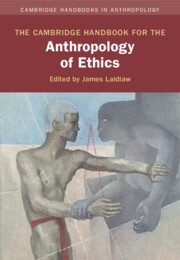Book contents
- The Cambridge Handbook for the Anthropology of Ethics
- Cambridge Handbooks in Anthropology
- The Cambridge Handbook for the Anthropology of Ethics
- Copyright page
- Contents
- Contributors
- 1 Introduction
- Part I Intellectual Sources and Disciplinary Engagements
- Part II Aspects of Ethical Agency
- 9 Making the Ethical in Social Interaction
- 10 Freedom
- 11 Responsibility
- 12 Emotion and Affect
- 13 Happiness and Well-Being
- 14 Suffering and Sympathy
- 15 Ambiguity and Difference
- Part III Media and Modes of Ethical Practice
- Part IV Intimate and Everyday Life
- Part V Institutional Life
- Index
- References
14 - Suffering and Sympathy
from Part II - Aspects of Ethical Agency
Published online by Cambridge University Press: 11 May 2023
- The Cambridge Handbook for the Anthropology of Ethics
- Cambridge Handbooks in Anthropology
- The Cambridge Handbook for the Anthropology of Ethics
- Copyright page
- Contents
- Contributors
- 1 Introduction
- Part I Intellectual Sources and Disciplinary Engagements
- Part II Aspects of Ethical Agency
- 9 Making the Ethical in Social Interaction
- 10 Freedom
- 11 Responsibility
- 12 Emotion and Affect
- 13 Happiness and Well-Being
- 14 Suffering and Sympathy
- 15 Ambiguity and Difference
- Part III Media and Modes of Ethical Practice
- Part IV Intimate and Everyday Life
- Part V Institutional Life
- Index
- References
Summary
Engaging two intertwined and yet competing literatures detailing moral aspects of suffering through the lenses of sympathy and empathy, this chapter examines the extent to which suffering (and responses to it) may be viewed as a condition of possibility for ethical/moral experience. While arguably distinctive responses to suffering that have unique ethical entailments, sympathy and empathy still share, however, a more primordial manifestation in pathos. Drawing upon insights from the phenomenological tradition, the chapter argues that pathic attunement is the generative, responsive ground from which sympathy and empathy arise. Moving beyond the either/or framework that often emerges in anthropological discussions of empathy and sympathy, a focus on pathos leads to a different way of envisioning suffering as a condition of possibility for moral experience. Without collapsing the ethical and political, pathos is thus a phenomenon through which recursive relationships between ethical, political, and ontological orientations to others becomes discernible and therefore analysable.
- Type
- Chapter
- Information
- The Cambridge Handbook for the Anthropology of Ethics , pp. 359 - 388Publisher: Cambridge University PressPrint publication year: 2023



